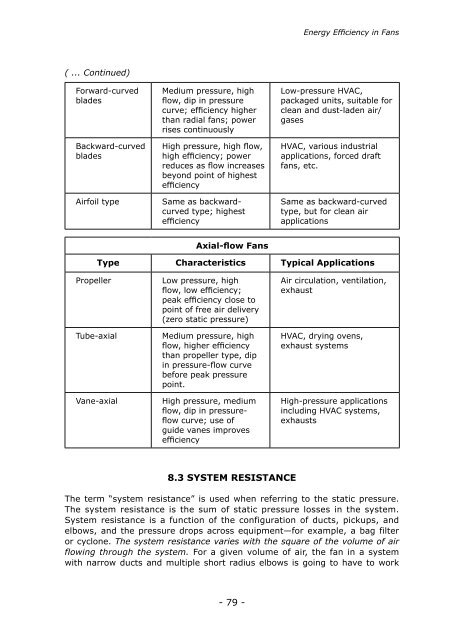Training Manual on Energy Efficiency - APO Asian Productivity ...
Training Manual on Energy Efficiency - APO Asian Productivity ...
Training Manual on Energy Efficiency - APO Asian Productivity ...
Create successful ePaper yourself
Turn your PDF publications into a flip-book with our unique Google optimized e-Paper software.
( ... C<strong>on</strong>tinued)<br />
Forward-curved<br />
blades<br />
Backward-curved<br />
blades<br />
Medium pressure, high<br />
flow, dip in pressure<br />
curve; efficiency higher<br />
than radial fans; power<br />
rises c<strong>on</strong>tinuously<br />
High pressure, high flow,<br />
high efficiency; power<br />
reduces as flow increases<br />
bey<strong>on</strong>d point of highest<br />
efficiency<br />
Airfoil type Same as backwardcurved<br />
type; highest<br />
efficiency<br />
Axial-flow Fans<br />
- 79 -<br />
<strong>Energy</strong> <strong>Efficiency</strong> in Fans<br />
Low-pressure HVAC,<br />
packaged units, suitable for<br />
clean and dust-laden air/<br />
gases<br />
HVAC, various industrial<br />
applicati<strong>on</strong>s, forced draft<br />
fans, etc.<br />
Same as backward-curved<br />
type, but for clean air<br />
applicati<strong>on</strong>s<br />
Type Characteristics Typical Applicati<strong>on</strong>s<br />
Propeller Low pressure, high<br />
flow, low efficiency;<br />
peak efficiency close to<br />
point of free air delivery<br />
(zero static pressure)<br />
Tube-axial Medium pressure, high<br />
flow, higher efficiency<br />
than propeller type, dip<br />
in pressure-flow curve<br />
before peak pressure<br />
point.<br />
Vane-axial High pressure, medium<br />
flow, dip in pressureflow<br />
curve; use of<br />
guide vanes improves<br />
efficiency<br />
8.3 SYSTEM RESISTANCE<br />
Air circulati<strong>on</strong>, ventilati<strong>on</strong>,<br />
exhaust<br />
HVAC, drying ovens,<br />
exhaust systems<br />
High-pressure applicati<strong>on</strong>s<br />
including HVAC systems,<br />
exhausts<br />
The term “system resistance” is used when referring to the static pressure.<br />
The system resistance is the sum of static pressure losses in the system.<br />
System resistance is a functi<strong>on</strong> of the c<strong>on</strong>figurati<strong>on</strong> of ducts, pickups, and<br />
elbows, and the pressure drops across equipment—for example, a bag filter<br />
or cycl<strong>on</strong>e. The system resistance varies with the square of the volume of air<br />
flowing through the system. For a given volume of air, the fan in a system<br />
with narrow ducts and multiple short radius elbows is going to have to work
















